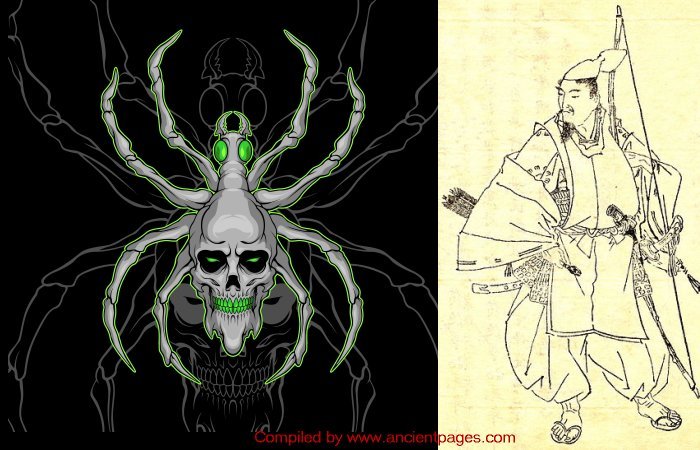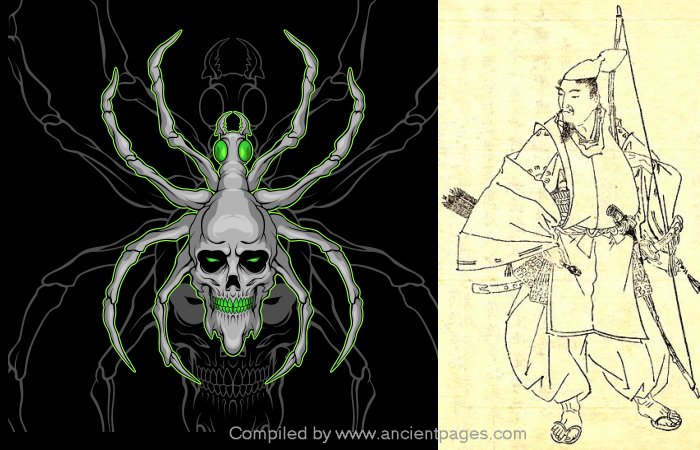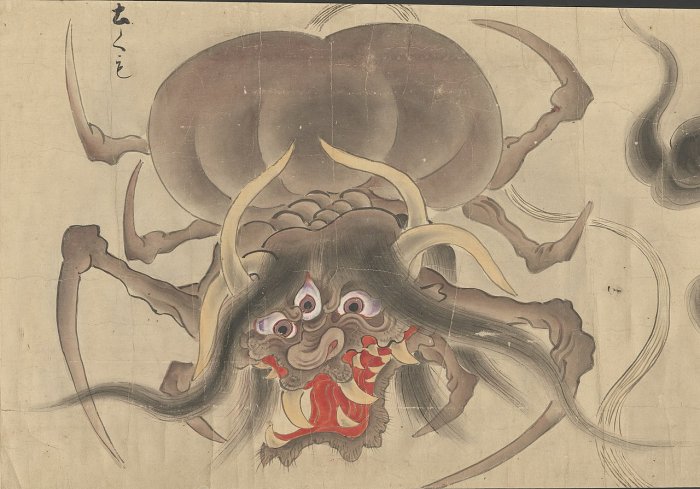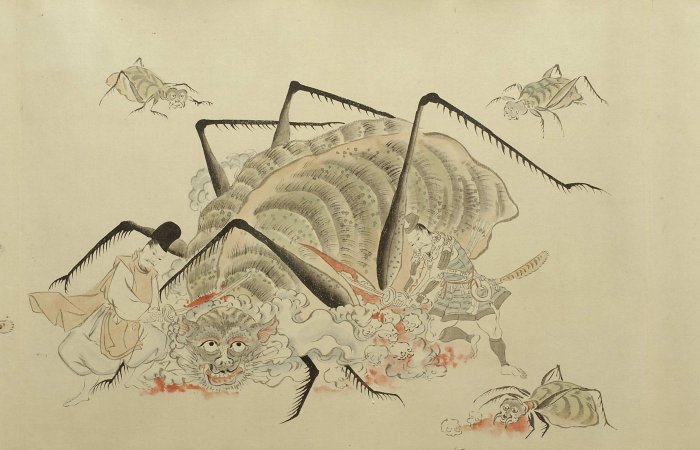Giant Spider Yokai Tsuchigumo Confronts Minamoto No Yorimitsu And Something Strange Happens

Ellen Lloyd – AncientPages.com – Despite their generally small size, spiders are often feared by many people.
The origins of arachnophobia, or the fear of spiders, have been debated for some time. Is the fear of spiders embedded into us as a species or a learned behavior influenced by cultural factors? A study by researchers from the Max Planck Institute for Human Cognitive and Brain Sciences in Germany suggests that the fear of snakes and spiders is evolutionarily rooted. They concluded that our brains possess mechanisms similar to those found in primates, which allow us to quickly identify and react to objects perceived as ‘spiders’ or ‘snakes.’1
Looking back at historical events, myths, and legends from across the world, we notice our ancestors were sometimes also frightened when they came across a spider, especially if they were much larger than ordinary arachnids.
This brings us to the curious story of Tsuchigumo, one of the most scary spiders mentioned in Japanese mythology.
The giant spider Tsuchigumo is mentioned in many Japanese tales. Tsuchigumo is a fearsome shapeshifting Yokai that relies on deception. In traditional Japanese folklore, Yokai, which translates to “strangeness, mystery, or suspicion” in Chinese kanji, are peculiar entities believed to inhabit the borderlands and intermediate spaces. These Yokai beings encompass many supernatural creatures, including ghosts, monsters, and spirits. They are known to manifest in diverse forms and can have both negative and positive impacts on humans.2
One interesting story of Yokai Tsuchigumo can be found in the in legend of Minamoto no Yorimitsu, (948 – August 29, 1021), a Japanese samurai and folk hero who served the regents of the Fujiwara clan along with his brother Yorinobu.
Unmasking The True Identity Of The Mysterious Priest Tsuchigumo no Seijitsua
The legend tells that Minamoto no Yorimitsu fell ill while pursuing a colossal demon skull. A mysterious priest named Tsuchigumo no Seijitsua would appear each evening to administer medication to help the samurai recover. Many days and nights passed, but Minamoto no Yorimitsu’s health showed no signs of improvement.
Kinmon Goro Munezo, one of Yorimitsu’s loyal retainers, became suspicious of the nightly nocturnal visitor and eventually exposed his true identity by reflecting Tsuchigumo no Seijitsua’s genuine form in a mirror. Upon witnessing the horrifying image of a monstrous spider-like entity reflected at him, Yorimitsu was filled with dread and attempted to slash the demon in two.
The two tsuba, or sword guards, portray the scene of Yorimitsu attempting to slice a tsuchigumo using a tachi named ‘Hizamaru’. These pieces were crafted by Unno Yoshimori I (on the left) and Gochiku Sadakatsu (on the right). Kept at the Museum of Boston. Credit: Slimhannya – CC BY-SA 4.0
Tsuchigumo was not captured, but as the giant earth spider fled, it left behind a trail of blood that guided Yorimitsu and his followers directly to its hideout. Upon arrival, Yorimitsu discovered the spider-demon had retreated into a hole and dispatched its offspring. Despite their best efforts, they were unable to locate any further signs of the demon’s existence. Consequently, Yorimitsu was compelled to use one of his retainers as bait by cutting his throat to draw out the Tsuchigumo. The spider demon was then slain with the Kumokirimaru sword, causing thousands of spiderlings to scatter from its body. Yorimitsu’s sword earned the name “Spider Cutter” following this event.3
Tsuchigumo As A Giant Shapeshifting Female Spider
In another legend, Tsuchigumo appears as a beautiful warrior woman who leads an army of yokai.
“With knowledge of magic and experience in combat, Yorimitsu’s first attack was a strike to the tsuchigumo directly.
The direct blow to the warrior women, lifted the illusion she had cast. Her army was not real, and disappeared into a ball of smoke, blinding Yorimitsu’s army temporarily and giving her time to escape.
Slithering up the mountain to an opening hidden among natural spider webs, the tsuchigumo thought it was safe.
Tsuchigumo depicted at the Bakemono no e scroll. Credit: Brigham Young University – CC BY-SA 4.0
However, the army of Yorimitsu tracked her down with the trail of blood it had left behind from the first blow cast by Yorimitsu. His army entered into battle against its mistress once she was found; found as a giant spider demon! Yorimitsu sliced her abdomen open with a single swing of the sword. To his shock, a thousand baby spiders swarmed out of her belly, but Yorimitsu and his retainers managed to kill every last one before returning as victors,” Zayden Stone writes in his book Mythical Creatures and Magical Beasts: An Illustrated Book of Monsters from Timeless Folktales, Folklore and Mythology.
The Tsuchigumo Zoshi Picture Scroll
The stories of the giant spider yokai, Tsuchigumo, have maintained their popularity over time and are frequently mentioned in numerous historical Japanese manuscripts and scrolls.
Among these, we find the impressive Tsuchigumo Zoshi picture scroll that is currently housed in the Tokyo National Museum. The scroll dates back to the first half of the fourteenth century, and consists of nine sections of writing and illustrations.
Part of the Tsuchigumo Zoshi Picture Scroll. Credit: Public Domain
“This picture scroll is the oldest extant work in which a spider is portrayed as a supernatural creature. In the process of transmission from one family to another, the paper has been damaged, causing lacunae, and the order of the sections has been misarranged. Fortunately, the order of the story and illustrations was restored to the original from a copy of Tsuchigumo zoshi dated 1764.” 4
What Is The Tsuchigumo Clan?
The clans known as tsuchigumo, especially those from Mount Yamato Katsuragi, have a significant reputation. According to legend, the Katsuragi Hitokotonushi Shrine is believed to be the site where Emperor Jimmu captured a tsuchigumo and buried its head, body, and feet separately. This act was performed to prevent any potential harm their grudges could inflict upon the living. 5
There has been an ongoing discussion among scholars about whether the mythological spider-demon originated before the historical clans or vice versa. The term ‘Tsuchigumo’, although initially associated with a lesser-known myth, was later adopted as a descriptor for a more tangible threat to the empire. “Alternately, the word tsuchigumo has been identified as a derivation of an older derogatory term, tsuchigomori, which roughly translates as ‘those who hide in the ground’.” 3
Written by – Ellen Lloyd – AncientPages.com
Copyright © AncientPages.com All rights reserved. This material may not be published, broadcast, rewritten or redistributed in whole or part without the express written permission of AncientPages.com
Expand for references








